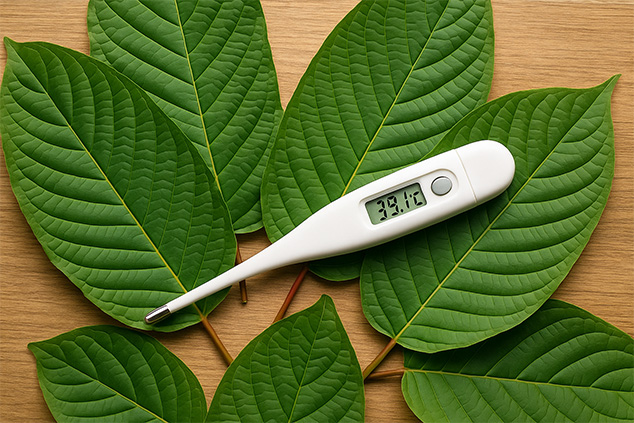While kratom use leads to countless positive and beneficial effects, improper use or intake of products that have questionable quality can lead to experiencing kratom side effects.
Constipation is a common complaint among kratom users. It’s also possible to experience some nausea if you take a dose that is too large for your body’s needs.
But how about a fever? Can kratom cause fever? Or is it something else?
To understand if kratom and fever are related, we should first understand what kratom is and how it works.
What’s Kratom, and How Does It Work?
The Southeast Asian herb kratom or Mitragyna speciosa has its wealth of beneficial properties. These include strong and effective pain relief, relaxation, stress and anxiety relief, euphoria, increased energy, improved mood, and more.
These effects are due to the alkaloids in kratom. While current studies have identified a minimum of 25 alkaloids and 40 total beneficial compounds, most of these chemical compounds are in trace amounts. However, two active alkaloids are considerably more abundant and are responsible for most of the effects.
The alkaloids in kratom engage with the opioid receptors in the brain. This helps to produce increased levels of dopamine and manage pain. Yet, it happens in a way that does not engage proteins that form addictive behaviors.
As a result, kratom is, in a way, similar to decaf coffee. You can get the taste of coffee without it keeping you up at night.
Kratom provides the effects that you can expect from pain-killers like opioids, but without making you addicted. In fact, studies indicate that Mitragyna speciosa is about as addictive as its close cousin coffee, which considerably less addictive that the media paints it.
Kratom Side Effects
When it comes to using kratom, it’s important to take the right dose for your body. This, though, can vary on multiple factors such as age, weight, body-fat percentage, and more.
If you take a bit too much, especially if it’s white or green vein kratom, you may end up experiencing kratom side effects. Some of the most common ones include:
- constipation,
- nausea,
- vomiting,
- dizziness,
- dry mouth,
- headache,
- stomach pain,
- reduced appetite, and
- drowsiness.
But how about a fever?
What Is a Fever?
A fever is a state when body temperature is higher than a person’s normal body temperature. While normal temperature can vary from one person to another, it is usually considered that a person has a fever if their body temperature rises above 98.6 degrees Fahrenheit or 37 degrees Celsius.
Fever in itself is not a disease. Instead, it is a sign of the body fighting an infection or an illness. Infections are usually the main cause of fevers.
This happens when there are viruses and bacteria present in your system. Since they can survive without issues at normal body temperature, your body’s immune system activates fever to raise your body temperature, making it much harder for viruses and bacteria to survive.
Other causes of fever may be vaccines, cancer, certain medication like antibiotics, anti-seizure drugs, and blood pressure medication, autoimmune diseases, or heat diseases.
Fevers that reach up to 105 degrees F or 40.55 degrees C don’t usually pose a threat to one’s life. They simply make one exhausted and weak.
Nonetheless, fevers that surpass 108 degrees F or 42.22 degrees C can possibly result in convulsions or death. Fever, in itself, does not cause death. But prolonged exposure to it can damage internal organs such as the brain and cause organ failure, which can lead to death.
This is why it is crucial to seek medical attention if your fevers keep rising.
With these details in mind, can kratom cause fever?

Can Kratom Cause Fever?
No, pure kratom cannot cause fever. However, there is a risk of getting exposed to something that may cause fever if you take kratom that is contaminated, adulterated, or improperly handled.
So, if kratom does not cause fever, why do some people feel feverish and sweaty after taking kratom?
That’s because Mitragyna speciosa interacts with opioid receptors in the brain in a very similar way to opioids. This can release mast cells, a type of cells that can trigger the same mechanism that causes regulation, heating up the body in the process.
As a result, your body will try to thermoregulate, resulting in sweats or hot flashes.
This I not the same as fever and is usually short-lived. The main reason for it is an excessive dose that your body is not ready for. While less commonly, this can also happen if you have been repeatedly taking extremely high doses, developed kratom tolerance, and abruptly stopped taking kratom, which may have resulted in withdrawal.
How to Not Feel Feverish and Sweaty after Taking Kratom
In order to not experience these side effects, you should take a dose that is adequate for your body and not exceed it. Here are a few extra tips you can follow to avoid feeling feverish after taking kratom:
1. Start with a Very Small Dose
This is especially true if you are rather new to kratom or are trying a new vendor. Since not all kratom has the same potency, you may not know how strong or not your powder is. Therefore, it’s always best to start off with a threshold kratom dose and gradually up it until you feel the desired effects.
If you have noticed that you have been repeatedly increasing your doses, however, it may be a good time to take a break from kratom to lower your tolerance and minimize withdrawal symptoms. If you aren’t ready to quit cold turkey, consider tapering off instead.
2. Measure Your Dose Using a Sensitive Digital Scale
Even a slight deviation from your normal dose can lead to experiencing side effects. If you dose kratom using a spoon, you don’t always know how many grams you take. With a sensitive digital scale, you can measure your dose precisely down to milligrams.
3. Keep a Kratom Diary
This is basically a log where you input your dosages, times of intake, and how you feel. While it may seem as something redundant, it can help you keep track of when you may be developing kratom tolerance as well as what may be causing your side effects.
4. Have Some Food in Your Stomach
While some kratom users take their dose on an empty stomach, others find it to be too much. You will learn what works best for you with some experimenting, it may be best to start off by taking kratom with or after some food. It will help your body break down the powder slower, making the onset of the effects smoother.
5. Hydrate Yourself
Drinking plenty of water will help your body replenish its water reserves if you sweat. In addition to that, it can help you prevent kratom constipation.
6. Buy High-Quality Kratom from Trusted Vendors
To avoid possible contamination and adverse effects, only select vendors whom you can trust. This will reduce the risks of kratom being improperly tested, contaminated, or laced with dangerous substances. If possible, look for vendors in states with a Kratom Consumer Protection Act in place.
Seek Medical Attention If Needed
If, however, you notice that your feverish sensation is not passing and your body temperature keeps rising, do not hesitate to seek medical attention. There is always a risk of kratom being contaminated with pathogens like Salmonella.
Have you ever experienced feverish sensations, hot flashes, or sweats after kratom? What caused it? How did you come with it?



Leave a Reply